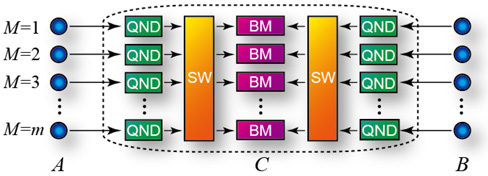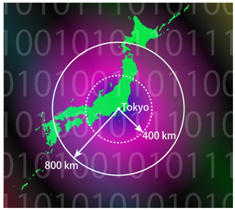All-photonic Intercity Quantum Key Distribution
Quantum key distribution (QKD), a technique for ultimately secure communication based on the law of physics, usually relies on the transmission of photons over optical fibres. In fact, based on the direct transmission of photons between a sender and a receiver, conventional QKD schemes are already commercially available for 100-km communication distances and testbed networks like the ‘Tokyo QKD network’ are running in Japan. Therefore, with the conventional schemes, intracity QKD links (over about 100 km) are available even at present. However, owing to the photon loss in the optical fibre, about 400 km is considered to be the maximum distance of the conventional schemes. Thus, to connect QKD networks in different cities above 400 km distant, it was thought that we needed ‘quantum repeaters’, rather than the conventional schemes based on the direct transmission. Quantum repeaters enable us to perform QKD over any communication distance efficiently, but, they necessitate many intermediate nodes connected with optical fibres, each of which needs challenging components such as matter quantum memories and quantum error correction. These requisites are necessary to achieve an extremely high goal such as intercontinental QKD connections. But, they may be too demanding to connect different major cities below 1,000 km separation.
In this research [1], we have proposed an ‘all-photonic intercity QKD’ protocol (Fig. 1) that doubles the achievable distance of the QKD without decreasing its efficiency, using only linear optical devices, that is, without matter quantum memories and quantum error correction required in quantum repeaters. This scheme could outperform quantum repeaters based on atomic ensembles for communication distances below 800 km, and it expands the communication range from 400 km of conventional schemes to 800 km (Fig. 2). In addition, since the proposed scheme does not use matter quantum memories similarly to all-photonic quantum repeaters [2], (a) it displays the communication speed in the same order of the repetition rate of optical devices, irrespective of the communication distance, (b) it does not need a still challenging interface between matter and photons and (c) it could work at room temperature in principle. Therefore, our scheme could work as cost-effective backbone links to connect metropolises within a radius of 800 km. If our scheme is combined with the all-photonic quantum repeater protocol, it is made seamless to realize the high-speed and cost-effective ‘all-photonic’ QKD network based only on optical devices on a global scale.
- [1] K. Azuma, K. Tamaki, and W. J. Munro, Nature Commun. 6, 10171 (2015).
- [2] K. Azuma, K. Tamaki, and H.-K. Lo, Nature Commun. 6, 6787 (2015).

|

|
| Fig. 1. All-photonic intercity QKD. The middle point C performs quantum nondemolition measurement (QND) on optical pulses sent by communicators AB. Optical switches (SW) then make only surviving photons paired, which are subjected to the Bell measurement (BM). | Fig. 2. Communication range expanded by our scheme. |